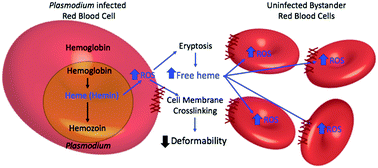Microfluidic analysis of red blood cell deformability as a means to assess hemin-induced oxidative stress resulting from Plasmodium falciparum intraerythrocytic parasitism
Abstract
Hemolytic anemia is one of the hallmarks of malaria and leads to an increase in oxidized heme (hemin) within the plasma of infected individuals. While scavenger proteins sequester much of the circulating heme, it has been hypothesized that extracellular heme may play a central role in malaria pathogenesis. We have previously developed the multiplex fluidic plunger (MFP) device for the measurement of red blood cell (RBC) deformability. Here, we demonstrate that the measurement of changes in RBC deformability is a sensitive method for inferring heme-induced oxidative stress. We further show that extracellular hemin concentration correlates closely with changes in RBC deformability and we confirm that this biophysical change correlates with other indicators of cell stress. Finally, we show that reduced erythrocyte deformability corresponds with both erythrophagocytosis and RBC osmotic fragility. The MFP microfluidic device presents a simple and potentially inexpensive alternative to existing methods for measuring hemolytic cell stress that could ultimately be used to perform clinical assessment of disease progression in severe malaria.

- This article is part of the themed collection: CSC100: Celebrating Canadian Chemistry


 Please wait while we load your content...
Please wait while we load your content...